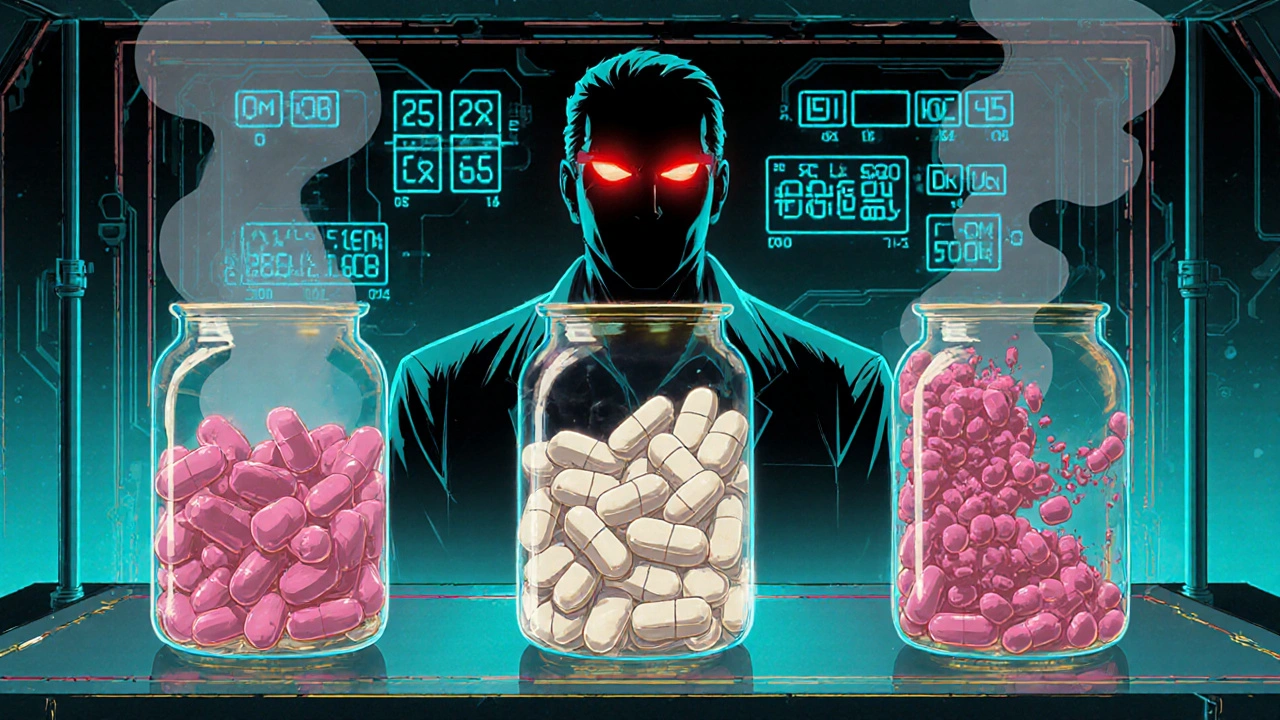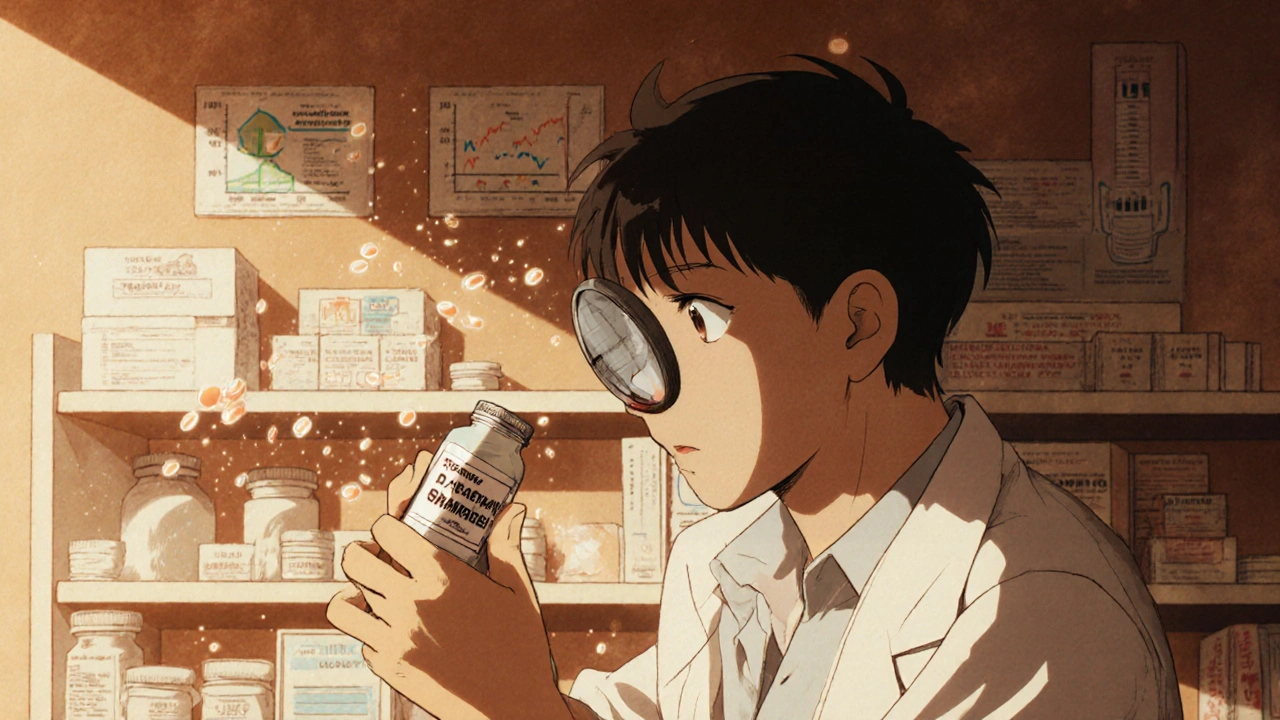When you pick up a generic pill at the pharmacy, you expect it to work just like the brand-name version. But how does the FDA make sure that generic drug doesn’t lose its strength, break down into harmful chemicals, or become ineffective before the expiration date? The answer lies in stability testing-a rigorous, science-driven process that every generic drug manufacturer must pass before the FDA will approve it.
Why Stability Testing Matters for Generic Drugs
Generic drugs aren’t just copies. They’re exact replicas in active ingredient, dosage, and intended use. But even small differences in inactive ingredients, manufacturing methods, or packaging can affect how a drug holds up over time. A tablet might crumble. A liquid might grow bacteria. A capsule might leak. Stability testing catches these problems before the drug reaches patients. The FDA requires that every generic drug prove it will remain safe and effective under real-world storage conditions-from your medicine cabinet to a hot warehouse in Texas. Without this data, there’s no way to know if a pill taken six months after manufacture still has the right amount of active ingredient. That’s why stability testing is the single biggest reason generic drug applications get rejected.What the FDA Actually Requires
The FDA’s expectations for stability testing are laid out in guidance documents like ICH Q1A(R2) and the 2018 ANDA Stability Q&A. Here’s what manufacturers must do:- Test at least three batches of the drug product, each made at pilot scale using current Good Manufacturing Practices (cGMP).
- Test each batch under two conditions: long-term and accelerated.
- Long-term testing: Store samples at 25°C ± 2°C and 60% ± 5% relative humidity for at least 12 months. This simulates normal storage.
- Accelerated testing: Store samples at 40°C ± 2°C and 75% ± 5% humidity for six months. This speeds up degradation to predict long-term behavior.
Testing isn’t just about checking if the pill still looks the same. The FDA requires analysis of physical, chemical, biological, and microbiological changes. That means:
- Active ingredient content (is it still 25 mg or has it dropped to 20 mg?)
- Impurity levels (are harmful breakdown products forming?)
- Disintegration time (does the tablet dissolve properly?)
- Microbial contamination (is there mold or bacteria?)
- Preservative effectiveness (for liquids and creams)
Testing frequency is strict: every 3 months in the first year, every 6 months in the second year, and once a year after that-until the proposed shelf life ends. For a 24-month expiration date, you need data points at 0, 3, 6, 9, 12, 18, and 24 months.
Container and Packaging Must Match
You can’t test a drug in a glass vial and then sell it in a plastic bottle. The FDA requires that the packaging used in stability testing be identical to what will be sold to consumers. Why? Because packaging affects how moisture and oxygen get in. A blister pack might protect a tablet better than a bottle with a child-resistant cap. If the packaging changes, the stability data is invalid.Even different sizes or strengths need separate testing-unless the manufacturer can scientifically justify using a method called bracketing or matrixing. Bracketing means testing only the strongest and weakest strengths in a family of products. Matrixing means testing only some batches at each time point, not all. Both require FDA approval and solid scientific reasoning.

How Generics Differ from Brand-Name Drugs
You might think generics have it easier because they copy an existing drug. But they don’t get a free pass. While brand-name companies spend years generating stability data during development, generic makers must prove their version behaves the same way.Here’s the key difference: brand-name companies often do forced degradation studies (like exposing the drug to extreme heat, acid, or light) to understand how it breaks down. Generics don’t need to do all of that-the reference drug’s degradation pathways are already known. But they must still show their product degrades in the same way. If the brand-name drug breaks down into three specific impurities, the generic must show the same impurities appear at similar levels.
That’s why 92.7% of stability-related deficiencies in generic applications come from mismatched degradation profiles or missing data points-not from lack of effort, but from oversight. One missed test, one incorrect storage condition, and the entire application can be rejected.
Common Reasons Generic Applications Get Rejected
Stability issues are the top reason the FDA issues Complete Response Letters (CRLs) to generic drug applicants. Here’s what goes wrong most often:- Missing or incomplete stability protocols - 98.3% of completeness failures are due to poorly written test plans.
- Inadequate sampling - Not testing enough batches or skipping time points. This accounts for 22.7% of deficiencies.
- Unvalidated test methods - If the lab can’t prove its method accurately measures the drug’s strength or impurities, the data is useless. This is cited in 31.2% of CRLs.
- Storage condition failures - Stability chambers must stay within ±2°C. FDA inspections found 63.2% of generic facilities had temperature excursions averaging 4.7°C, sometimes multiple times a month.
These aren’t minor errors. They’re red flags that the manufacturer doesn’t fully understand or control the process. The FDA doesn’t accept “we thought it was fine.” They need data. And they need it to be perfect.
Real-World Challenges for Manufacturers
Running stability studies isn’t cheap or quick. It takes 6-9 months just to train staff on ICH Q1A methods. The average cost per ANDA application for stability testing is $487,500-nearly 19% of total development costs. For small companies, that’s a huge barrier.Indian manufacturers, who make up 40.3% of U.S. generic approvals, account for 62.8% of all stability-related rejections. Why? Often, it’s not lack of skill-it’s pressure to cut costs. Stability chambers are expensive to run and monitor. Some facilities cut corners on environmental controls, leading to data that doesn’t hold up under FDA scrutiny.
Solutions are emerging. Top manufacturers now use automated monitoring systems that track temperature and humidity in real time and send alerts if something goes wrong. That’s now standard for 78.4% of the largest generic producers. Others use pre-submission meetings with the FDA to get feedback on their stability protocols before filing-reducing rejection rates by over 40%.

What’s Changing in 2025 and Beyond
The rules are getting stricter. In June 2025, the FDA released a draft guidance proposing new requirements:- All new ANDAs must include 24 months of real-time stability data-not just 12.
- Manufacturers must use Quality by Design (QbD) principles, meaning stability testing is built into the product design from day one, not added as an afterthought.
- New rules for nanomaterials, which behave unpredictably over time.
- International harmonization (ICH Q1C(R2)) will require more detailed photostability testing and climate zone-specific storage data.
On the tech side, the FDA is piloting blockchain for stability data verification. Imagine a tamper-proof digital ledger that records every temperature reading, every test result, every batch number. That could cut down on fraud and errors.
But not everyone agrees these changes are necessary. Some experts argue that for well-established drugs-like metformin or lisinopril-that have been on the market for decades, the current testing burden is excessive. They say the FDA should allow more flexibility for products with proven track records.
The Congressional Budget Office estimates that if reforms pass, up to 38.7% of the generic market by value could qualify for reduced testing. But for now, the rules are strict-and they’re here to stay.
What This Means for Patients
You might not think about stability testing. But it’s why your generic blood pressure pill still works after six months on the shelf. It’s why your insulin doesn’t spoil in your purse during a summer trip. It’s why you can trust that a $4 generic version of a $400 brand-name drug is just as safe and effective.The FDA’s system isn’t perfect. It’s slow, expensive, and sometimes frustrating for manufacturers. But it works. Every time you take a generic drug, you’re benefiting from hundreds of hours of lab work, thousands of data points, and a regulatory system designed to keep you safe.
Stability testing isn’t just paperwork. It’s the invisible shield between you and a drug that might not work-or worse, could hurt you.
What happens if a generic drug fails stability testing?
If a generic drug fails stability testing, the FDA issues a Complete Response Letter (CRL) rejecting the application. The manufacturer must fix the issue-often by re-running tests, improving packaging, or adjusting the formulation-and resubmit. This can delay approval by months or even years. In some cases, the product never makes it to market.
Do all strengths of a generic drug need separate stability data?
Yes, unless the manufacturer uses bracketing or matrixing, which must be scientifically justified and approved by the FDA. For example, if a company makes 5 mg, 10 mg, and 20 mg tablets, they might only test the 5 mg and 20 mg versions and use data from those to support the 10 mg version. But they must prove the degradation behavior is consistent across all strengths.
How long does stability testing take before FDA approval?
Stability testing typically takes 12 to 24 months to complete for real-time data. Manufacturers often start testing early in development so that by the time they submit their ANDA, they have at least 6 months of long-term data and 6 months of accelerated data-enough for the FDA to make an initial decision. Full data for the entire shelf life is required after approval.
Can accelerated testing alone be used to set an expiration date?
No. Accelerated testing can only support a tentative expiration date. The FDA requires real-time (long-term) stability data to confirm the final expiration date. Manufacturers must continue long-term testing even after the drug is approved to ensure the expiration date remains valid.
Are there exceptions to stability testing for well-known generic drugs?
Currently, no. Even for drugs that have been on the market for decades, the FDA requires full stability data for each new manufacturer. However, proposed regulatory reforms in 2024 may allow reduced testing for certain well-established products in the future, but these changes have not yet been finalized.
What Comes Next for Generic Drug Manufacturers
The pressure is on. With more scrutiny, higher costs, and tighter deadlines, generic manufacturers must invest in better systems, better training, and better data. Those who do will get approved faster. Those who don’t will keep getting rejected.For patients, this means more reliable, affordable medications. For the industry, it means a tougher road-but one that ensures every pill you take is exactly what it claims to be.








So let me get this straight - we spend half a million bucks and two years testing pills so they don’t turn into science experiments in your bathroom cabinet, and yet someone in a warehouse in Houston leaves them in a truck for three days at 110°F and we’re supposed to trust the system? I’m not mad, just impressed by how much paperwork it takes to keep a $4 tablet from killing me.
Also, why does the FDA care if my insulin doesn’t spoil in my purse but not if my coffee creamer goes bad after two weeks? Hypocrisy is the only thing more stable than these generics.
92.7% of stability deficiencies are mismatched degradation profiles - that’s not oversight, that’s incompetence disguised as compliance. Labs are running HPLC methods validated on a 2010 laptop running Windows XP while the FDA’s guidance documents were written in 2023. The data’s garbage. The approval’s a gamble. And you’re paying for it with your blood pressure meds.
And don’t get me started on Indian manufacturers. 62.8% of rejections? That’s not a statistic, that’s a warning label.
WHO CARES ABOUT ALL THIS TECHNICAL STUFF? WE NEED CHEAP MEDS AND THE FDA IS HOLDING UP AMERICA’S HEALTH BECAUSE SOME LAB TECH CAN’T READ A THERMOMETER. THIS ISN’T A PHD THESIS, IT’S A PILLS THAT KEEPS PEOPLE ALIVE. STOP OVERENGINEERING AND JUST APPROVE THE DRUGS THAT WORK. WE’RE NOT IN EUROPE HERE.
Also, why do we even need 24 months of data for metformin? It’s been around since the 1950s. It’s basically sugar with a fancy name.
just wanted to say thanks for explaining this so clearly. i never thought about how much work goes into a $4 pill. the fact that it doesnt turn to dust or poison me after 6 months is kinda wild when you think about it.
keep doing the good work, FDA. we see you.
There is no excuse for the systemic negligence in generic drug stability testing. Every time a manufacturer skips a time point, mislabels a batch, or fails to validate an analytical method, they are risking human life. This isn’t about bureaucracy - it’s about ethics. The FDA’s standards are not too strict; they’re barely sufficient.
And to those who say, ‘It’s too expensive’ - tell that to the family whose loved one had a stroke because their generic blood thinner degraded. Money doesn’t save lives. Data does.
Let’s be real - stability testing is the only thing standing between you and a bottle of glitter powder labeled as lisinopril. The fact that 63.2% of facilities have temp excursions means someone’s pocketing the savings from not upgrading their chillers.
And yeah, I’m calling out the Indian manufacturers again - not because they’re bad, but because they’re the most visible. The system rewards speed over science. Fix the incentives, not the people.
imagine if your phone battery had to pass a 2-year test before you could buy it. we do this for pills. that’s wild.
also, why is no one talking about how blockchain could fix this? just saying.
As someone who’s worked in pharma labs across three continents, I’ve seen the good, the bad, and the terrifying. In South Africa, we used ice chests and manual logbooks. In Germany, we had AI-driven environmental monitors. In the U.S., we had both - in the same building.
The real story isn’t about FDA rules. It’s about global inequality in healthcare infrastructure. The same pill that passes in Ohio might fail in Lagos - not because the science is different, but because the fridge isn’t plugged in.
Stability testing isn’t just regulation. It’s justice.
This is the kind of deep dive that makes you appreciate the invisible work behind your daily meds. I used to think generics were just cheaper knockoffs - now I see them as quiet heroes. The scientists running those 24-month tests? They’re not chasing fame. They’re just making sure your grandma’s blood pressure pill doesn’t turn into a time bomb.
Let’s not wait for reform to celebrate the people doing the hard, boring, life-saving work. They deserve more than a footnote in a regulatory document.
Also - yes, blockchain would be epic. But let’s start with fixing the damn temperature sensors first.